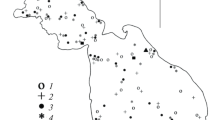Abstract
In discussions concerning the possible construction of a Panamá sea-level canal it has been assumed that Gatún Lake, part of the present canal, acts as a fresh-water barrier to the migration of marine animals from either end of the Canal to the other. Methodical documentary salinity determinations have not been made previously, and only a few surface salinity observations have been recorded. Determinations of salinity-temperature profiles made in spring and fall, 1972, show essentially freshwater to be present from Miraflores Lake, through the Pedro Miguel Locks, through Gatún Lake, to, and including, the upper chambers of the Gatún Locks. With the exception of those of the lower chamber of the Miraflores Locks, the profiles indicate homogeneity and thorough vertical mixing of all water masses in the lock systems and lakes of the canal. Homogeneity of the water in the lock chambers is thought to be due to turbulence during filling of the chambers, to the “piston-effect” of large ships moving into the chambers, to the action of ships' propellers, and to density currents established as the lock gates are opened. Water in the approach channel at the Pacific end appears to be more homogeneous than that at the Atlantic end. The Panama Canal does, in fact, constitute a fresh-water barrier to the migration of the stenohaline marine biota of the Pacific and Atlantic Oceans.
Similar content being viewed by others
Literature Cited
Abele, L. G.: Introductions of two freshwater decapod crustaceans (Hymenosomatidae and Atylidae) into North and Central America. Crustaceana 23, 209–218 (1972).
Bozniak, E. G., N. S. Schanen, B. C. Parker and C. M. Keenan: Limnological features of a tropical meromictic lake. Hydrobiologia 34, 524–532 (1969).
Dawson, C. E.: Occurrence of an exotic eleotrid fish in Panamá with discussion of probable origin and mode of introduction. Copeia 1973 (1), 141–144 (1973).
Glynn, P. W.: Observations on the ecology of the Caribbean and Pacific coasts of Panamá. Bull. biol. Soc. Wash. 1972 (2), 13–30 (1972).
Hildebrand, S. F.: The Panama Canal as a passageway for fishes, with lists and remarks on the fishes and invertebrates observed. Zoologica, N. Y. 24, 15–45 (1939).
Menzies, R. J.: Transport of marine life between oceans through the Panama Canal. Nature, Lond. 220, 802–803 (1968).
Rubinoff, L.: The sea-level canal controversy. Biol. Conserv. 3, 33–36 (1970).
Author information
Authors and Affiliations
Additional information
Communicated by J. Bunt, Miami
Rights and permissions
About this article
Cite this article
Jones, M.L., Dawson, C.E. Salinity-temperature profiles in the Panama Canal Locks. Marine Biology 21, 86–90 (1973). https://doi.org/10.1007/BF00354602
Accepted:
Issue Date:
DOI: https://doi.org/10.1007/BF00354602




